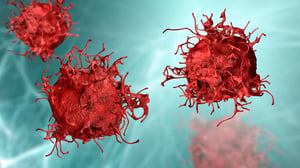All eyes are on the HIF-1α gene, which helps the melanoma and other forms of cancer to develop even when there is very little oxygen. When deactivated, the tumour cells cannot survive.
A technique whereby tumours are literally suffocated may well, in the coming years, become a new strategy for combatting cancer, particularly melanoma, as well as other types, and for rendering immunotherapy more effective.
The idea has been prompted by a well-known property of tumour cells: their ability to use even tiny amounts of oxygen with the utmost efficiency, enabling many types of cancer (unlike healthy cells) to survive even in hypoxia (namely a lack of oxygen) in the surrounding micro-environment (the hypoxia being partly down to the rapid growth of the tumour, which “steals” available oxygen). As a result, experiments are now underway on how to actually suffocate tumours.
Recent studies have in fact shown that certain types of tumour develop better in a state of hypoxia, because the lack of oxygen prevents the immune system from intervening, leaving the way open for the cancerous cells. The way tumours manage this strategy is highly complex (and indeed daunting).
But it has recently been discovered that a gene called HIF-1α (Hypoxia Inducible Factor-1 alpha) plays a key role in all of this. Amongst other things, research into HIF-1α and the way in which cells (not just tumour cells) use oxygen earned three scientists - William G. Kaelin Jr, Peter J. Ratcliffe and Gregg L. Semenza - the Nobel Prize for medicine in 2019.
Genetic engineering techniques
In the wake of these studies, recent times have seen the spotlight on the role which HIF-1α can play in the growth (or suppression) of tumours. Many international research groups are now actively working on this field.
One interesting study has just been published in the Oncogene scientific magazine of the Nature group: its authors, from Luxembourg, France and the United Arab Emirates attempted to inhibit the HIF-1α gene using genetic engineering to trigger destruction of the tumour cells, which were left without oxygen.
Using a technique known as CRISPR, the academics deactivated HIF-1α in the melanoma cancer cells and saw that, in the laboratory, growth of the tumour then halted, and the immune system’s lymphocytes appeared to be generated in far greater numbers than when HIF-1α was fully enabled.
It is easy to deduce that the addition of potential anti HIF-1α drugs may at the very least enhance immunotherapy, and more generally actually slow the growth of the tumour.
Test on 500 patients
The data obtained in the laboratory have also been indirectly confirmed in clinical trials.
In analysing the characteristics of almost 500 melanoma patients, researchers particularly noted that those with the worst prognosis were also patients displaying the highest hypoxia level in the tumour mass, causing them to display poor reactions to immunotherapy.
Melanoma is in fact a type of skin cancer which develops from melanocytes, cells which are responsible for producing melanin (the pigment which, amongst other things, causes skin to tan).
Owing to their rapid growth rate and low blood flow, melanomas often feature large areas of hypoxia.
Experiments using HIF-1α inhibitors will be continuing already in the coming months. The hope is that direct-action drugs against this gene will soon be produced and used in conjunction with other forms of therapy, or even on their own.

